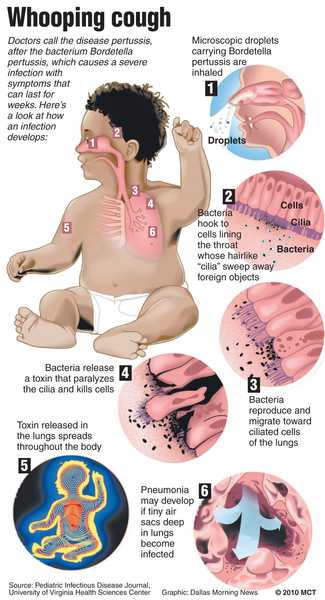A once almost eradicated disease is back and on the rise.
Whooping cough is a respiratory infection which presents with a very distinctive cough. There has been an increase in the number of cases of whooping cough over the years. Adolescents and young adults represent a great number of cases but the highest rates are in infants age less than three months. Unvaccinated infants are at the highest risk of severe complications such as pneumonia, apnea, and seizures. This disease is highly contagious and has a mortality rate of 95% in developing countries. Protection through natural infection or vaccination is not life-long. Therefore, it is important to follow a vaccination schedule, set up by your physician, starting at age two months. It is important for pregnant women to receive the vaccine between the 28th and 38th weeks of pregnancy to pass on short-term immunity to their newborn.
I have been in this moms shoes. My son was only 9 weeks old when he contracted whooping cough. He had only received one vaccination against this disease the week before he started coughing. Not enough time to give him any protection. It took almost two weeks and countless trips to the physician and one five hour trip to the emergency room at 11 o’clock at night before someone could tell me why my son was turning blue when he coughed. You see, he didn’t cough at the doctors office. No, there he slept soundly. After watching this get increasingly over 10 days I’d had enough. I couldn’t sit and watch this happen to him anymore. My husband and I went to the emergency room and waited four hours for him to cough. Finally, someone got to see what I was talking about. Another hour and we were in an ambulance headed to the children’s hospital 45 mins away. We spent nine days in the PICU, and another 18 months on an apnea (breathing) monitor attached to his foot at night. This was an extremely stressful period in our life. Everyone that had come in contact with my son was put on antibiotics as a preventative measure. It was too late for me and my husband, we both contracted it too.
Whooping cough is transmitted via droplets in the air from coughing and sneezing, with individuals being infectious from just before and up to 21 days after the onset of cough. Infants less than one year old, about half are hospitalized, the younger the infant the more likely hospitalization is, while less than 5% of teenagers and adults with the disease are admitted to the hospital. Infants are more likely to develop severe complications, with death secondary to whooping cough mainly occurring in young infants. Older children and adults can transmit the infection to infants who have not yet been vaccinated.
Bordetella pertussis is a bacteria, which attaches itself to and damages ciliated respiratory tissue in the nasopharynx, and bronchi and bronchioles. It then produces toxins that paralyse the cilia and cause local tissue damage and inflammation, leading to impaired mucus clearance.

Potential respiratory complications of whooping cough include pneumonia, bronchitis, asphyxia, pneumothorax, pulmonary hypertension, and rupture of the diaphragm. All suspected cases are required to be reported to the State Health Department for tracking of disease.
This is a preventable disease. Parents please vaccinate your children less than age 7 with the DTap vaccine and with the Tdap for anyone over the age of seven.
References
Bentley, J., Pinfield, J., & Rouse, J. (2013). Whooping cough: identification, assessment and management. Nursing Standard, 28(11), 50-57. doi:10.7748/ns2013.11.28.11.50.e7911
Kochlar, S. (2012). Preventing the spread of whooping cough. Independent Nurse, 30-32.
Richards, S., & Schub, T. (2016). Whooping Cough in Adolescents and Adults. CINAHL Nursing Guide,

Hi Stacy,
I found your blog to be informative. I have debated the topic of vaccinating versus not vaccinating many times as I have a family member who chooses not to vaccinate their daughter. I have researched it multiple times but never really explored the idea of what not vaccinating your child could do to another child who might be too young or too fragile to receive vaccines. It occurred to me the significance of herd immunity and just how imperative it is to maintain in order to prevent outbreaks. Your blog was relatable and the fact that you have a personal experience you could share really helped me understand not only the importance of vaccinating but also the consequence of not vaccinating. I also found the you tube video to be compelling. The woman who initially spoke told a story. You could see how emotionally and physically exhausted she was while caring for a child who contracted pertussis as well as feel her regret for not choosing the booster during her 3rd trimester. Choosing to vaccinate doesn’t just protect the individual but helps protect infants who are not able to receive the vaccine at such a young age. Pertussis is preventable.